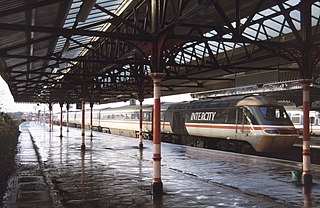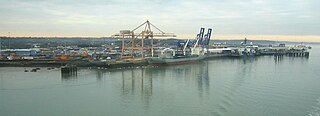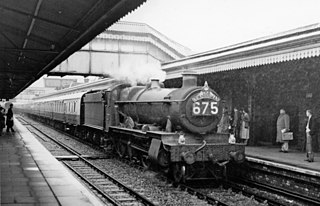
The London and North Eastern Railway (LNER) was the second largest of the "Big Four" railway companies created by the Railways Act 1921 in Britain. It operated from 1 January 1923 until nationalisation on 1 January 1948. At that time, it was divided into the new British Railways' Eastern Region, North Eastern Region, and partially the Scottish Region.

The Great Eastern Main Line is a 114.5-mile (184.3 km) major railway line on the British railway system which connects Liverpool Street station in central London with destinations in east London and the East of England, including Shenfield, Chelmsford, Colchester, Ipswich and Norwich. Its numerous branches also connect the main line to Southminster, Braintree, Sudbury, Harwich and a number of coastal towns including Southend-on-Sea, Clacton-on-Sea, Walton-on-the-Naze and Lowestoft.

The Great Eastern Railway (GER) was a pre-grouping British railway company, whose main line linked London Liverpool Street to Norwich and which had other lines through East Anglia. The company was grouped into the London and North Eastern Railway in 1923.

InterCity was a brand name introduced by British Rail in 1966 for its long-haul express passenger services.

The London and North Eastern Railway (LNER) Class V2 2-6-2 steam locomotives were designed by Sir Nigel Gresley for express mixed traffic work, and built at the LNER shops at Doncaster and Darlington between 1936 and 1944. The best known is the first of the class, 4771 Green Arrow, which is the sole survivor of the class.

The London and North Eastern Railway (LNER) Thompson Class B1 is a class of steam locomotive designed by Edward Thompson for medium mixed traffic work.

Harwich International railway station is a railway station on the Mayflower Line, a branch of the Great Eastern Main Line, the station serves Harwich International Port in Essex, England. It is 68 miles 72 chains (110.88 km) from London Liverpool Street, between Wrabness to the west and Dovercourt to the east. Its three-letter station code, HPQ, derives from its original name, Harwich Parkeston Quay.

Dutchflyer is an integrated passenger service between the United Kingdom and the Netherlands. Formerly known as Amsterdam Express, Dutchflyer is a rail/sea/rail service operated jointly by Stena Line, the Dutch state railway operator Nederlandse Spoorwegen, Greater Anglia, and the Rotterdam metro and bus company Rotterdamse Elektrische Tram.

Walton-on-the-Naze railway station is one of the two eastern termini of the Sunshine Coast Line, a branch of the Great Eastern Main Line, in the East of England. It serves the seaside town of Walton-on-the-Naze, Essex. It is 70 miles 15 chains (113.0 km) down the line from London Liverpool Street. Its three-letter station code is WON. The preceding station on the line is Frinton-on-Sea.

The London and North Eastern Railway (LNER) Thompson Class B2 was a class of 4-6-0 steam locomotive. It was introduced in 1945 as a two-cylinder rebuild of the three-cylinder LNER Class B17. Ten were rebuilt from Class B17 but no more were rebuilt because of the success of the LNER Thompson Class B1.

Harwich Town railway station is the eastern terminus of the Mayflower Line, a branch of the Great Eastern Main Line, in the East of England, serving the port town of Harwich, Essex. It is 70 miles 61 chains (113.88 km) from London Liverpool Street; the preceding station on the line is Dovercourt. Its three-letter station code is HWC.

Harwich International Port is a North Sea seaport in Essex, England, and one of the Haven ports. It lies on the south bank of the River Stour one mile upstream from the town of Harwich, opposite the Port of Felixstowe. The port was formerly known as Parkeston Quay.

The Cornish Riviera Express is a British express passenger train that has run between London Paddington and Penzance in Cornwall since 1904. Introduced by the Great Western Railway, the name Cornish Riviera Express has been applied to the late morning express train from London to Penzance continuously through nationalisation under British Rail and privatisation under First Great Western, only ceasing briefly during the two World Wars. The name is also applied to the late morning express train running in the opposite direction from Penzance to London. Through performance and publicity the Cornish Riviera Express has become one of the most famous named trains in the United Kingdom and is particularly renowned for the publicity employed by the Great Western Railway in the 1930s which elevated it to iconic status. Today it is operated by the Great Western Railway train operating company.

The Cornishman is a British express passenger train to Penzance in Cornwall. From its inception in the 19th century until before World War II it originated at London Paddington. Under British Railways the name was applied to a different service, starting variously from Wolverhampton, Leeds or Bradford. In 2006, First Great Western, now Great Western Railway, reintroduced the named service which now runs once per day from Monday to Saturday in both directions.

London and North Eastern Railway (LNER) Thompson Class B1 No. 1264, is a preserved British steam locomotive.

Ipswich engine shed was an engine shed located in Ipswich, Suffolk on the Great Eastern Main Line. It was located just south of Stoke tunnel and the current Ipswich railway station. Locomotives accessed the site from Halifax Junction which was also the junction for the Griffin Wharf branch of Ipswich docks. The depot opened in 1846 and closed in 1968 although the site remained in railway use for a further thirty years.

The Benjamin Britten was an international train service linking Amsterdam with London. The train service was named after English composer Benjamin Britten due to his international status and his association with East Anglia, through which the service passes.
The Fenman is a named passenger train operating in the United Kingdom.

The NER Class V was a class of twenty steam locomotives of the 4-4-2 wheel arrangement. They were designed by Wilson Worsdell for the North Eastern Railway (NER) as express passenger locomotives.


















